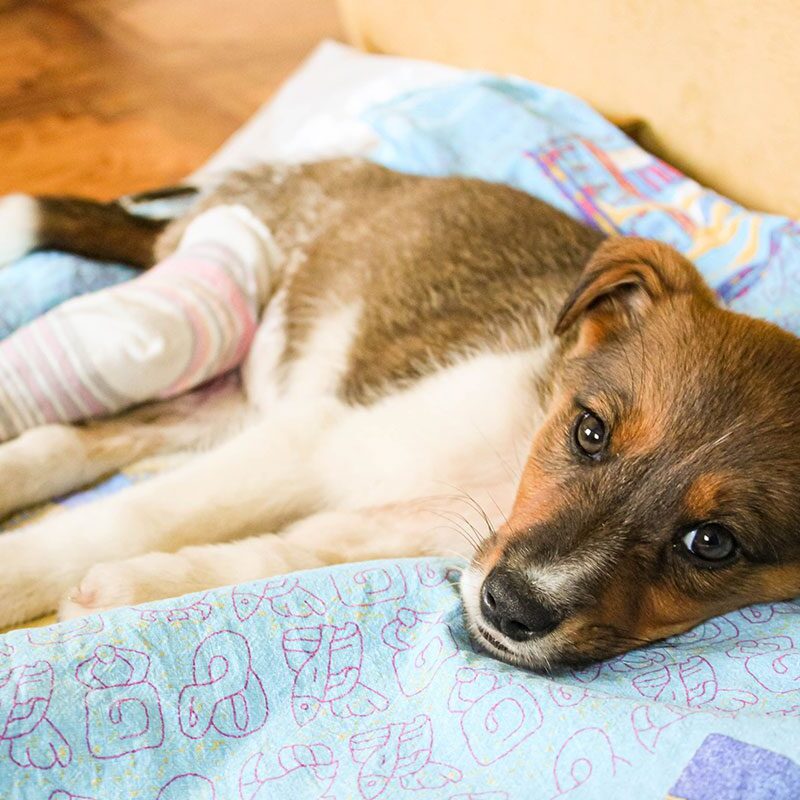
Salter-Harris fractures are injuries that involve the growth plate (physis) in young, growing dogs. The growth plate is a thin line of cartilage near the ends of bones that allows them to grow in length as the dog matures. Because the growth plate is the weakest part of the developing bone, it is more susceptible to injury and fracture than the surrounding areas.
Causes of Salter-Harris Fractures
These fractures are most often caused by trauma, such as:
- Falls
- Being hit by a car
- Accidents during play or exercise
Signs to Watch For
If your young dog has a Salter-Harris fracture, you may notice:
- Lameness or Limping: Reluctance or refusal to bear weight on the affected limb.
- Pain: Sensitivity to touch or pain when the joint is moved.
- Swelling or Bruising: Visible swelling or discoloration at the injury site.
- Deformity: In some cases, a bent, twisted, or abnormal limb appearance.
Types of Salter-Harris Fractures
Salter-Harris fractures are classified into six types based on how the growth plate and surrounding bone are affected:
- Type I: Fracture occurs straight across the growth plate without affecting the bone. Generally has the best prognosis.
- Type II: Fracture passes through the growth plate and part of the metaphysis (the area above the growth plate). Most common type.
- Type III: Fracture goes through the growth plate and into the epiphysis (the rounded end of the bone), involving the joint.
- Type IV: Fracture extends through the epiphysis, growth plate, and metaphysis, involving the joint.
- Type V: Crush injury to the growth plate. May not be visible on X-rays until growth arrest occurs. Has the worst prognosis.
- Type VI: Periosteal bridging between the metaphysis and epiphysis, which can lead to angulation deformities.
Treatment
- Surgery: Most cases, especially Types III and IV, require surgical repair to restore joint alignment and prevent growth abnormalities. Procedures often use pins, screws, or plates for stabilization.
- Closed Reduction and Stabilization: Less severe fractures, such as Type I and II, may be managed with realignment and casting or splinting.
- Emergency Care: Immediate orthopedic consultation is recommended if a fracture is suspected.
- Pain Control: NSAIDs and other pain medications help manage discomfort and inflammation.
- Implant Removal: Depending on the case, surgical implants may be removed after healing.
Recovery
- Activity Restriction: Strict rest (crate confinement, leash walks) for several weeks to prevent re-injury or implant failure.
- Rehabilitation: Passive range-of-motion exercises and therapies to restore joint mobility and muscle strength.
- Follow-Up: Regular checkups and X-rays to monitor healing and detect any complications early.
Potential Complications and Long-Term Outlook
- Growth Arrest: Premature closure of the growth plate may result in limb shortening or deformity.
- Osteoarthritis: Increased risk of developing OA in the affected joint later in life.
- Implant Complications: Loosening, infection, or failure of surgical hardware.
- Limb Length Discrepancy: Uneven growth between limbs.
- Re-Injury: The affected limb may remain more vulnerable.
Prognosis
Prognosis depends on fracture type, location, the dog’s age, and how quickly treatment begins. With timely and proper care, many Salter-Harris fractures have a good to excellent outcome. However, close monitoring is important to identify and manage any growth abnormalities or long-term joint issues.
Recent Posts
About Us
Knox Veterinary Surgery provides advanced orthopedic, soft tissue, and exotic pet surgeries right in your practice, making care easier for you and your clients. Serving Tennessee and surrounding states, we deliver skilled, compassionate care in a familiar setting.
